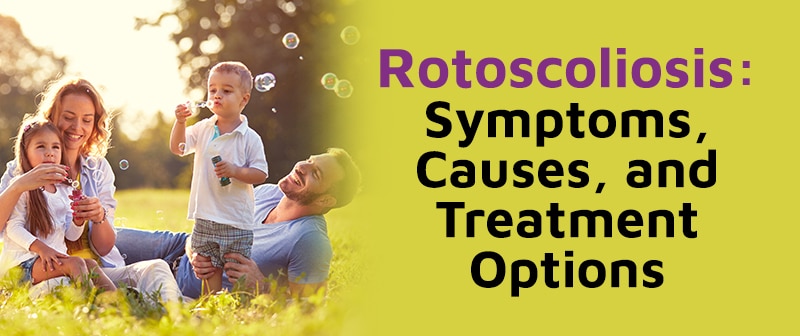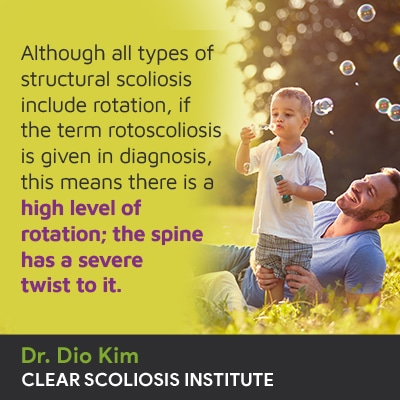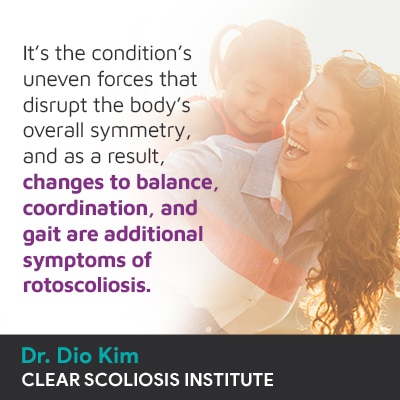
Scoliosis is a complex condition with different severity levels and types. The severity of the unnatural spinal curve, and its level of rotation, are significant condition factors that shape the design of effective treatment plans. When a scoliotic spine has a lot of rotation, this is rotoscoliosis and factors into the types of symptoms it causes, and the condition’s treatment needs.
Scoliosis is an unnatural sideways spinal curvature, and a scoliotic spine doesn’t just bend to the side, but also twists; it’s the rotational component that makes scoliosis a 3-dimensional condition. When there is an excessive amount of rotation, this is called rotoscoliosis.
There are a number of different spinal conditions that involve a loss of its healthy curves, and to be diagnosed with scoliosis, certain parameters have to be met.
Being diagnosed with scoliosis means an unnatural sideways spinal curve has developed, with a rotational component, and a minimum Cobb angle of 10 degrees.
If a healthy spine was viewed from the front and/or back, it would appear straight, but when viewed from the sides, it takes on a soft ‘S’ shape, and this is due to the spine’s natural and healthy curves.
The spine’s healthy curves make it more flexible, better able to absorb/distribute mechanical stress, and stronger, like a coiled spring.
If the spine loses one or more of its natural curves, its overall health, biomechanics, and function are disrupted, as the spine’s vertebrae (bones) are no longer aligned.
When scoliosis is diagnosed, part of the process involves comprehensive assessment to further classify conditions based on key patient/condition variables: patient age, curvature location, condition type (cause), and severity.
Condition severity is classified based on a patient’s Cobb angle measurement which is taken during X-ray; it involves drawing lines from the tops and bottoms of the most-tilted vertebrae, at its apex, and the intersecting angle is expressed in degrees.
The higher a patient’s Cobb angle, the more out of alignment the spine is:
Mild scoliosis: Cobb angle measurement of between 10 and 25 degrees
Moderate scoliosis: Cobb angle measurement of between 25 and 40 degrees
Severe scoliosis: Cobb angle measurement of 40+ degrees
So while Cobb angle measures the size of the unnatural sideways spinal curve, rotation refers to how much it twists from front to back, back to front, and just as there are different degrees of severity, the level of rotation also varies from patient to patient.
Scoliosis is a structural condition, meaning it involves an abnormality within the spine itself, which is why effective treatment, first and foremost, has to impact the condition on a structural level.
True scoliosis is structural, not postural, and this means that along with the spine’s unnatural sideways bend, it also coincides with rotation, meaning it twists, making it a complex 3-dimensional condition.

Because of the excessive amount of rotation in rotoscoliosis cases, they are more complex to treat, making symptoms such as postural deviation and pain, more likely to be overt.
With an increased rotational component in cases of rotoscoliosis, the spine’s misalignment is more pronounced, making its effects more noticeable.
As the spine and brain work in tandem to form the body’s central nervous system, it’s involved in the function of numerous systems at work within the body, which is why the effects of spinal conditions like scoliosis can be felt throughout the body.
Part of the reason scoliosis is so often referred to as a complex condition is because it ranges so widely in severity, which you’ll likely recall from the wide range of Cobb angle measurements; in fact, scoliotic curves can range from 10 to 100+ degrees.
As a progressive condition, scoliosis also has it in its nature to worsen over time, meaning where a scoliosis is at the time of diagnosis is not indicative of where it will stay; mild scoliosis can easily become moderate or severe, if left untreated, or not treated proactively.
Only proactive treatment can counteract the condition’s progressive nature.
In addition to a patient’s Cobb angle and amount of rotation, a patient’s progressive rate also factors into symptoms they are likely to experience.
While each case is different, which is why treatment plans have to be customized to address key patient/condition variables, common visual symptoms of rotoscoliosis include:

In addition, rotoscoliosis is generally more painful as the spine’s unnatural twist is excessive, making the condition more severe, and this is particularly the case with scoliosis in adults, for whom the condition has become compressive.
When it comes to rotoscoliosis causes, they are the same as scoliosis in general.
While there are different condition types a person can develop, the most prevalent is adolescent idiopathic scoliosis (AIS), diagnosed between the ages of 10 and 18.
The idiopathic designation means not clearly associated with a single-known cause, and idiopathic scoliosis is also the most common type to affect adults.
Approximately 80 percent of scoliosis cases are classified as idiopathic, while the remaining 20 percent of scoliosis cases are associated with known causes: neuromuscular, congenital, degenerative, and traumatic.
Neuromuscular Scoliosis Causes
In cases of neuromuscular scoliosis, the scoliosis is caused by the presence of a larger neuromuscular condition such as muscular dystrophy, cerebral palsy, or spina bifida, to name a few.
These types of cases are complex as communication between the brain and the muscles that support the spine is disrupted, causing the development of a scoliotic curve.
In treatment, it’s the neuromuscular condition that has to be the focus as it’s the underlying cause of the scoliosis.
Congenital Scoliosis Causes
Congenital scoliosis is rare, affecting approximately one in 10,000, and it develops in utero, due to a malformation within the spine itself that’s present at birth.
This can include misshapen vertebrae; healthy vertebrae are rectangular in shape so they can remain stacked on top of one another in a straight and neutral alignment, and when a vertebrae is more triangular in shape, it can affect the spine’s ability to maintain its natural curves and alignment.
Congenital scoliosis can also develop when vertebrae fail to develop into separate and distinct vertebral bodies, becoming fused together into one solid bone.
Degenerative Scoliosis Causes
Degenerative scoliosis is the second most common type to affect adults, is most common over the age of 40, and is caused by natural age-related spinal degeneration.
It’s more common in women than men, related to hormone and bone density changes caused by menopause, and most often, it’s the intervertebral discs that are the first spinal structures to deteriorate.
If a disc deteriorates and/or becomes desiccated, it will lose height, and its change in shape affects the position of adjacent vertebrae that attach to the disc in between, shifting the spine out of alignment.
Traumatic Scoliosis
As the name suggests, traumatic scoliosis is caused by a significant trauma experienced by the spine, such as in a car accident or fall.
In addition, the presence of tumors pressing on the spine can also force it out of alignment and cause the development of traumatic scoliosis.
So within these different types of scoliosis, just as the degree of severity can vary, so too can the degree of rotation, and the more severe the condition, and the higher the level of rotation, the more likely the condition is to be painful and cause noticeable disruptions to posture.
Following a diagnosis of rotoscoliosis, the most important decision is how to respond with treatment.
Different treatment approaches offer different potential outcomes, so it’s important for patients to be aware of all the options available to them.
The complex nature of scoliosis necessitates the customization of effective treatment plans by integrating different treatment disciplines so conditions can be impacted on every level.
As a structural condition, scoliosis has to, first and foremost, be impacted on a structural level, and this can be worked towards through a series of chiropractic techniques and manual adjustments that realign the spine.
When combined with a variety of therapies for increasing core strength so the spine is optimally supported by its surrounding muscles, and custom-prescribed scoliosis-specific exercises for rehabilitation, the spine can be further stabilized for long-term sustainable results.
As a CLEAR-certified scoliosis chiropractor, I treat patients with a proactive conservative chiropractic-centered treatment approach that strives to prevent progression, while preserving as much of the spine’s natural function as possible.

CLEAR provides a unique and innovative way of understanding scoliosis. Sign up to receive facts and information you won’t find anywhere else.
